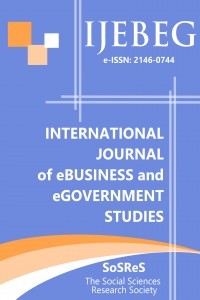INSTITUTIONAL ISOMORPHISM BETWEEN THE TRNC AND TURKEY FOR E-GOVERNMENT STRATEGY: WHAT ENCOURAGES SPONTANEOUS ISOMORPHISM?
INSTITUTIONAL ISOMORPHISM BETWEEN THE TRNC AND TURKEY FOR E-GOVERNMENT STRATEGY: WHAT ENCOURAGES SPONTANEOUS ISOMORPHISM?
e-Government, TRNC Turkey, institutional isomorphism, spontaneous isomorphism,
___
- Backus, M. (2001). eGovernance and developing countries: introduction and examples, IICD
- Research Brief, No:3, http://www.ftpiicd.org, [Accessed 15.12.2008].
- Chandler, S. and Emanuels, S. (2002). Transformation Not Automation, Proceedings of 2nd
- European Conference on E-Government, pp. 91-102, Oxford, UK. Fennell, M.L. (1980). The effects of environmental characteristic on the structure of hospital clusters, Administrative Science Quarterly, 25: 484-540.
- Heeks, R. (2002). E-Government in Africa: Promise and Practice, Information Polity: The International Journal of Government and Democracy in the Information Age, 7(2/3): 97.
- Hinings, B., and R. Greenwood. 1988. The normative prescription of organizations. In Institutional patterns and organizations: Culture and environment, ed. L.G. Zucker, 53–70. Cambridge, Mass.: Ballinger.
- Howard, M. (2001). E-Government across the Globe: How will “e” change Government?,
- Government Finance Review, 17(4): 6-9.pp. Jaffee, D. (2008). Organizational Theory: Tension and Change. McGraw-Hill Education (UK) Ltd.
- Kachwamba, M. and Hussein, A. (2009). Determinants of e-Government maturity: Do organizational specific factors matter?, ICEGOV: Advances in eGovernment and eGovernance
- (Ed. A. Kaplan, A. Balci, C.C.Aktan, Ö.Dalbay), in 67-78pp., Ankara;: SOBİAD and TURKSAT. Laumann, E.O.; Galaskiewicz, J.; Marsden, P. (1978). Community structure as interorganizational linkage, Annual Review of Sociology, 4, 455-484.
- Layne, K. and Lee, J. (2001). Developing fully functional e-Government: a four stages model,
- Government Information Quarterly, 18(2):122.p. Mallinson, W. (2005). Cyprus: A modern history. London: I.B. Tauris & Co Ltd.
- Meyer, J.W. (1979). The impact of the centralization of educational funding and control on state and local organizational governance, Stanford University, Program report No: 79-B20.
- Meyer, J.W., and B. Rowan. 1977. Institutionalized organizations: Formal structure as myth and ceremony. American Journal of Sociology, 83: 340–63.
- Misuraca, G. (2006). E-Governance in Africa, from theory to action: a practical oriented research and case studies on ICT for Local governance, ACM International Conference Proceedings Series:
- Proceedings of the 2006 International Conference on Digital Government Research.
- Mizruchi, M.S. and Fein, L.C. (1999). The Social construction of organizational knowledge: a study of uses of coercive, mimetic and normative isomorphism. Administrative Science Quarterly, : 653-683.
- Peters, B.G. 2001. Institutional Theory in Political Science: the new institutionalism. London: Continuum.
- Reffat, R. (2003). Developing a successful e-government: opportunity and challenges, The Symposium on e-Government , Muscat: Oman.
- Sagsan, M. (2001). E-Devlet: Toplumların Yeni Umut Işığı mı?, Stratejik Analiz, Kasım, 89- pp.
- Sagsan, M. and Yildiz, M. (2009). E-government in the Turkish Republic of Northern Cyprus. (ed. C. Reddick) Comparative E-Government in 409-423 pp., New York: Springer.
- Sozen, C. and Sagsan, M. (2009). Social network versus technical networks: how different social interaction patterns effect information systems utilization in the organizations?, Journal of US
- China Public Administration, 6(7): 65-72. Silcock, R. (2001). What is e-Government, Parliamentary Affairs, 54, 88-101.
- United Nations e-Government Survey (2008). e-Government Survey : from e-Government to
- Connected Governance, New York: UN. White, H.; Boorman, S.A. and Breiger, R.L. (1976). Social Structure from multiple networks. I.
- Blockmodels of roles and positions, American Journal of Sociology, 81:730-780. Yildiz, M. (2009). E-Government policy processes from a grounded theory perspectives: the case of Turkey, Saarbrücken: Lambert Academic Publishing.
- Başlangıç: 2009
- Yayıncı: Sosyal Bilimler Araştırmaları Derneği
TACIT KNOWLEDGE EXTRACTION FOR SOFTWARE REQUIREMENT SPECIFICATION
Serbülent ÜNSAL, Meryem AYAS, Tunc Durmuş MEDENİ
Ahmet Ozturk, Koray Umit, Ihsan Tolga Medeni, Burak Ucuncu, Meryem Caylan, Firat Akba, Tunc Durmus Medeni
GLOBAL PRODUCTION NETWORKS and KNOWLEDGE TRANSFER MECHANISIMS
Cansu DURUKAN, M.Teoman PAMUKÇU
Muhajir Kachwamba, Iddi Makombe
A CASE STUDY FOR TURKEY: A SECURE PAPER-BASED ELECTRONIC VOTING SYSTEM
Oktay Adalier, Fatih Birinci, Süleyman KARDAŞ, Mehmet Sabır KİRAZ
APPLYING MOBILE TECHNOLOGIES FOR PERSONNEL RECRUITING –AN ANALYSIS OF USER-SIDED ACCEPTANCE FACTORS
Susanne J. NİKLAS, Stephan BÖHM
REFERENDUMS AND E-VOTING IN TURKEY
Rabia Bahar ÜSTE, Berrin GÜZEL
Burcu Bastabak, Tunc Durmus Medeni
